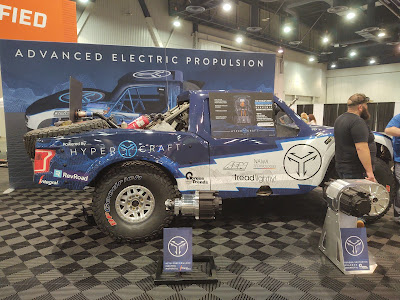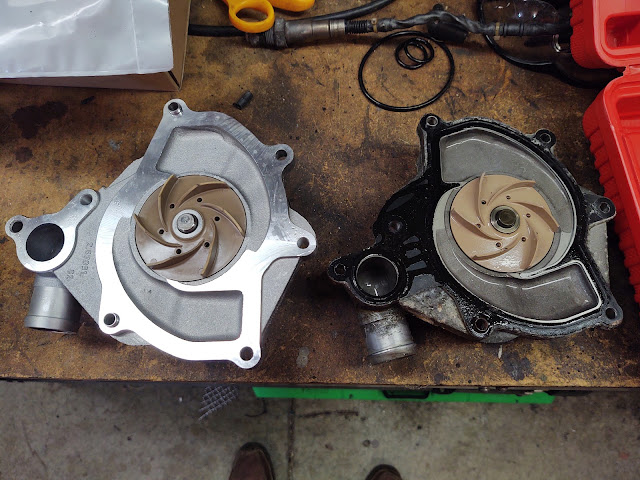The SEMA Show
The Specialty Equipment Manufacturers Association (SEMA) offered a new Friday Experience where they sold a limited number of tickets to the public to attend SEMA Friday. I bought one of those tickets and attended. I have wanted to attend SEMA ever since I first heard about it from Hot Rod magazine writeups back in the 1970's. This years event was the largest convention in Las Vegas for 2021. I have been to MINExpo in 2021, and CONEXPO in 2020, both at the Las Vegas Convention Center as well and SEMA is a bigger show using all of the convention center halls as well as most of the parking lots. My Garmin watch reported over 19,000 steps and almost 11 miles of walking for the day. It's nice the LVCC Loop helps get you between some of it without as much walking. I did not get to most of the stuff in the parking lots which took up all of the Central Hall lots, and likely more. It is a huge show to cover in one day.
SEMA is about more than just aftermarket vehicles and equipment. It also focuses on shops that service or modify vehicles. SEMA has many vendors of tools, shop equipment, training, software, and pretty much everything a shop would need to service or modify vehicles.
SEMA had an area they called SEMA Electrified. This area showcased mostly BEV performance.
At the end of the show they have an event called SEMA Ignite where a parade of vehicles from the show drive through the parking lot of the West Hall past a bunch of bleachers. They have live music and beer too. They block off Convention Center Drive from the LVCC Central Hall to the parking lot of the West Hall where SEMA Ignite is. They also block off Paradise Road for a block in each direction. This made it a challenge to get an Uber home.
Cat had some products there, in 2 different areas.
There were of course plenty of press there so you can find many great photos, articles, and videos online from SEMA. The pro's obviously have far better equipment and skill than me with my 2.5 year old smartphone. Below are some videos I captured.
Here is a playlist of 360-degree videos I took.
Aftermarket Performance Future
Another thing that attracted me to SEMA was to see where industry was with electrification. I wrote this article earlier about what I see as a likely path for future aftermarket performance. While full battery electric (BEV) conversions are happening, I have only found Vonnen doing hybrid conversions so far. There are retailers selling Tesla motors and systems. GM and Ford have both advertised "crate" electric motors. Ford did show off their Eluminator truck built on their e-crate motor that does have a part number and the article claims you can order it now.
There were other companies offering BEV components at SEMA such as Blacmotor and Torque Trends.
I can see a real future for full BEV conversions, but I also see a market for hybrids conversions which appears pretty much unserved except for Vonnen.
Many look at the trends and see the bigger leap direct to BEV in all cases. I see it a bit differently. I agree there is a market for BEV conversions and they are compelling in many ways but I also see a market for enhancements to internal combustion engine (ICE) vehicles. This market is larger than some think in my opinion. There is something about hearing the sound of an engine that really matters to some. I am one of those it matters to. Maybe that desire runs stronger in older folks. I wrote an article about this earlier in this blog. For those people (which includes me), hybrid really makes sense. The use case for performance hybrid is very different than hybrid focused on fuel economy, as all the mainstream hybrids are. Hybrid has been in racing for years now. Look at F1 KERS for instance, or recent LeMans race cars. Hybrid powertains are everywhere. Sports cars often look to racing to adopt those approaches to enhance the performance of street/track sports cars. Supercars are already well down this path too. Some of the first were the Porsche 918, Ferrari LaFerrari, and the McLaren P1 which came out years ago. Many more have followed.
The other issue to consider is the increasing focus and regulation around emissions. The California Bureau of Auto Repair (BAR) has increased focus on going after modified vehicles. The days of modifying flash files and tunes are nearing an end. Other aftermarket equipment that negatively impacts emissions will face increased scrutiny and eventual ban going forward as well. Hybrid retrofits do not suffer these risks since they will result in neutral or decreased emissions, and they do not negatively impact emissions control or OBD.
The performance benefits of electric and hybrid are clear. Electric motors give a very different powerband than ICE engines. Their performance peaks in the RPM range are opposites. Combining the 2 together give a much flatter performance curve and really fill in the low end power gaps that ICE engines have, particularly naturally aspirated ICE engines. Adding hybrid has no effect on the engine sound, other than to allow it to rev even quicker. The driver experience is enhanced with no downside.
Some may look at the hybrid retrofit and claim the extra weight will be a bug downside. That would be true if the net weight gain was significant, or worse, poorly placed in the vehicle. They would also look at BEV and plug-in hybrids and claim those batteries are heavy and expensive, which is true. However, the battery capacity needed for performance enhancement is much smaller than what you need for BEV and plug-in hybrid where you are trying to save fuel. Vonnen's system uses a 1kWh battery. Most BEVs require more like 80kWh or larger. Vonnen's system also adds a total of 170lbs but places is lower in the chassis. The only real downside of Vonnen's system I can see if the cost. I believe as BEV and hybrids go more mainstream, we will see these costs go down. I really like what Vonnen has done here and I think they are only the first of many to come.
I believe that hybrid and electric offer many benefits over an ICE powertain. Those include:
- The energy storage (batteries, ultra-caps) can be more strategically placed around the vehicle in more optimum places for the weight. You can also have multiple smaller battery packs to optimize weight location.
- Energy storage can use a combination of batteries and ultra-capacitors based on optimizing for the use cases of the vehicle. Other future energy storage devices can also be used.
- Multiple motor/generators can be used. This allows for better active torque vectoring without the use of the brakes.
- Electric motor/generators are not only used for propulsion, but also play a part in braking. I like track days and brakes take a real beating on track days. Absorbing some of that braking energy with the electric system can be a real advantage.
- Multiple motor/generators can be placed to drive each wheel independently. This will allow for torque vectoring to optimize deceleration in and acceleration out of corners on the track. It is also a better way to manage traction control overall.
- Electric motor/generator control is very fast. There is very little time lag between a command and the actual torque application. This response is far better than any ICE powertrain and give a new level of control.
- When using multiple motor/generators, a single failure will not leave the vehicle incapacitated. It is like having multiple engines on a airplane. You can limp home even if one or more fail as long as you have enough for the job.
- You can enhance a hybrid system to also drive an electric supercharger. When used with a Roots or screw supercharger, a motor/generator driving the supercharger can be used in place of the traditional throttle. This can recover some otherwise wasted energy from the Otto-cycle engines during light loads. You can also create custom tuned boost curves to optimize for the ICE engine.
- You can dispense with all the ICE belt driven accessories like alternator, HVAC, and power steering. Even the water pump can go electric drive. This can also eliminate most or all of the related hoses from those systems. The HVAC can be all hard lines instead of hoses since the compressor can now be body mounted. Electric assist power steering already exists. Eliminating all this belt driven stuff lets the engine rev quicker too.
- Engine attached motor/generators like the Vonnen system allows for the removal of the alternator and starter. No longer do you have that noisy starter to start the engine. This can also be used for anti-stall and stall recovery where the motor/generator are used to maintain idle speed even if the engine dies.
- In the case of highly modified engines, the engine attached motor/generator can by used to stabilize the idle. The Aston Martin Valkyrie is a great example of this where the hybrid system is used to make the car more drivable.
- It is possible, especially in off-road vehicles, to recover energy from the suspension using electro-magnetic suspension dampers (shocks). These can be used to actively control vehicle ride. Electro-magnetic suspension control can be used to eliminate the sway bars and instead have the ride height actively controlled. This will allow the off-road vehicle to rock climb and keep all the wheels in contact with the ground while also preventing body roll at high speeds. Body roll can be actively eliminated completely improving performance of all vehicles. In fact, negative body roll can be implemented. Since some of the energy is being recovered rather than generating waste heat, the devices would not have as much of a heat problem as shocks do in off-road racing. Their performance can be temperature compensated too, whereas tradition shocks change performance when hot versus cold.
- Optionally, auto start/stop could be implemented for street cars. When combined with moving the belt driven accessories to electric drive, you can sit in comfort with the HVAC ON and engine off for some time. This would be great for a daily driver in town. Like many hybrids today, the motors can both start the engine and start the vehicle moving at the same time giving good response to accelerate from a stop (unlike non-hybrid start/stop systems).
- The ICE can be electrically warmed up. ICE engine wear is much higher on a cold engine. The less cold operation the better. Using the hybrid generator to drive an electric engine heater will both worm the engine faster, and heat the coolant faster.
- An electric heater can be used for cab heat and windshield defrosting until the engine warms up. This is safer as well as more comfortable.
- Trailers can also be equipped with motor/generators. This can allow for all the wheels to be driven in poor traction conditions so you don't get stuck. It also allows for regenerative braking. The trailer can have its own battery, or connect into the vehicles electrical system.
- Electric winches can be smaller and much more powerful using the high-voltage electrical system.
- Electric PTO accessories can by used to drive various things that tradition PTO systems did.
- The list goes on and on.



































